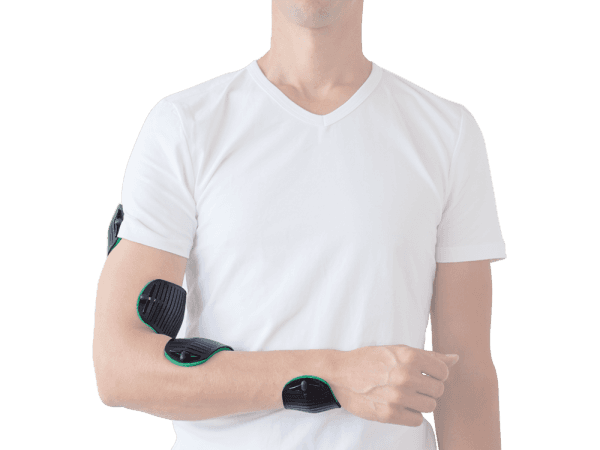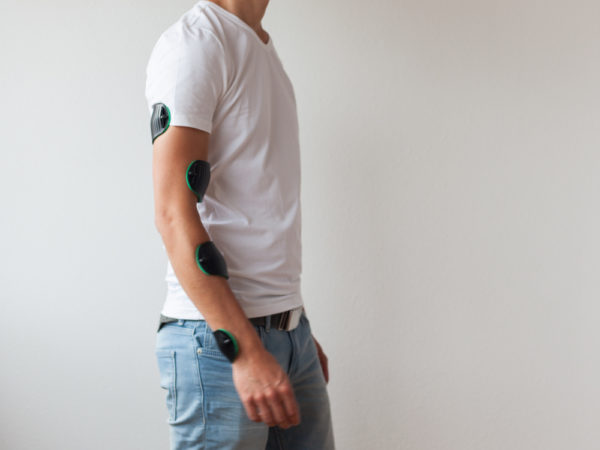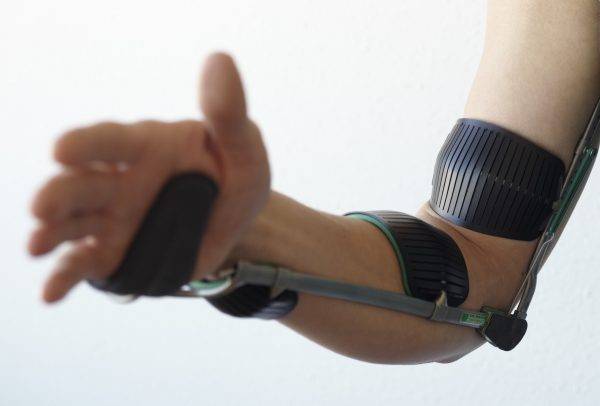 The Wilmer Elbow Orthosis on the arm. Because the orthosis is carried on the inside of the arm it is almost not visible. It's cosmetic while it's functional.[/caption]
The Wilmer Elbow Orthosis is truly a high-level engineering achievement. Due to its clever design, it is possible to move and lock the arm without having to use the other arm. During the design-proces a lot of attention has been paid to the user. As a result, the design is optimized for cosmesis and comfort. The orthosis is custom-made so that a perfect fit will give you the best comfort.
A Wilmer Elbow Orthosis is intended for people with reduced control over, or failure of the muscles around the elbow. This, for example, can be seen in case of a Plexus Brachialis lesion. Also after a stroke (CVA), muscle failure may have occurred. The result may be that control over the elbow is impaired. That can have serious consequences. Even the simplest of actions like buttoning your shirt or zipping your pants, carrying a bag or opening a full coke bottle can all of a sudden appear almost impossible. With the Wilmer Elbow Orthosis, some functionality is restored to the paralysed arm.
The Wilmer Elbow Orthosis on the arm. Because the orthosis is carried on the inside of the arm it is almost not visible. It's cosmetic while it's functional.[/caption]
The Wilmer Elbow Orthosis is truly a high-level engineering achievement. Due to its clever design, it is possible to move and lock the arm without having to use the other arm. During the design-proces a lot of attention has been paid to the user. As a result, the design is optimized for cosmesis and comfort. The orthosis is custom-made so that a perfect fit will give you the best comfort.
A Wilmer Elbow Orthosis is intended for people with reduced control over, or failure of the muscles around the elbow. This, for example, can be seen in case of a Plexus Brachialis lesion. Also after a stroke (CVA), muscle failure may have occurred. The result may be that control over the elbow is impaired. That can have serious consequences. Even the simplest of actions like buttoning your shirt or zipping your pants, carrying a bag or opening a full coke bottle can all of a sudden appear almost impossible. With the Wilmer Elbow Orthosis, some functionality is restored to the paralysed arm.
Wilmer Elbow Orthosis
Lightweight, dynamic, smart control
for a paralysed arm
 The 35° locking position of the Wilmer Elbow Orthosis is intended to reduce the "arm sway" during walking. This position is the natural state of the elbow while moving the arm while walking. The lock ensures that the arm stays in the plane with the body, so that you control the arm and its movements again. Your arm movements appear natural again, even during walking. You no longer need to tuck your arm away in the pocket of your jacket.[/caption]
The 35° locking position of the Wilmer Elbow Orthosis is intended to reduce the "arm sway" during walking. This position is the natural state of the elbow while moving the arm while walking. The lock ensures that the arm stays in the plane with the body, so that you control the arm and its movements again. Your arm movements appear natural again, even during walking. You no longer need to tuck your arm away in the pocket of your jacket.[/caption]  The Wilmer Elbow Orthosis with hand support, seen from the inside of the arm
The Wilmer Elbow Orthosis with hand support, seen from the inside of the arm 





















